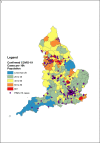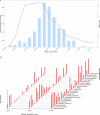Paediatric multisystem inflammatory syndrome temporally associated with SARS-CoV-2 (PIMS-TS): Prospective, national surveillance, United Kingdom and Ireland, 2020
- PMID: 34027512
- PMCID: PMC8132575
- DOI: 10.1016/j.lanepe.2021.100075
Paediatric multisystem inflammatory syndrome temporally associated with SARS-CoV-2 (PIMS-TS): Prospective, national surveillance, United Kingdom and Ireland, 2020
Abstract
Background: Paediatric Multisystem Inflammatory Syndrome temporally associated with SARS-CoV-2 (PIMS-TS), first identified in April 2020, shares features of both Kawasaki disease (KD) and toxic shock syndrome (TSS). The surveillance describes the epidemiology and clinical characteristics of PIMS-TS in the United Kingdom and Ireland.
Methods: Public Health England initiated prospective national surveillance of PIMS-TS through the British Paediatric Surveillance Unit. Paediatricians were contacted monthly to report PIMS-TS, KD and TSS cases electronically and complete a detailed clinical questionnaire. Cases with symptom onset between 01 March and 15 June 2020 were included.
Findings: There were 216 cases with features of PIMS-TS alone, 13 with features of both PIMS-TS and KD, 28 with features of PIMS-TS and TSS and 11 with features of PIMS-TS, KD and TSS, with differences in age, ethnicity, clinical presentation and disease severity between the phenotypic groups. There was a strong geographical and temporal association between SARS-CoV-2 infection rates and PIMS-TS cases. Of those tested, 14.8% (39/264) children had a positive SARS-CoV-2 RT-PCR, and 63.6% (75/118) were positive for SARS-CoV-2 antibodies. In total 44·0% (118/268) required intensive care, which was more common in cases with a TSS phenotype. Three of five children with cardiac arrest had TSS phenotype. Three children (1·1%) died.
Interpretation: The strong association between SARS-CoV-2 infection and PIMS-TS emphasises the importance of maintaining low community infection rates to reduce the risk of this rare but severe complication in children and adolescents. Close follow-up will be important to monitor long-term complications in children with PIMS-TS.
Funding: PHE.
Crown Copyright © 2021 Published by Elsevier Ltd.
Conflict of interest statement
Prof. Semple reports grants from DHSC National Institute of Health Research UK, grants from Medical Research Council UK, grants from Health Protection Research Unit in Emerging & Zoonotic Infections, University of Liverpool, during the conduct of the study; other from Integrum Scientific LLC, Greensboro, NC, USA, outside the submitted work. Dr. Ramanan reports personal fees from EliLilly, personal fees from Roche, personal fees from SOBI, personal fees from UCB, personal fees from Abbvie, personal fees from Novartis, outside the submitted work.
Figures




Similar articles
-
Clinical Characteristics of 58 Children With a Pediatric Inflammatory Multisystem Syndrome Temporally Associated With SARS-CoV-2.JAMA. 2020 Jul 21;324(3):259-269. doi: 10.1001/jama.2020.10369. JAMA. 2020. PMID: 32511692 Free PMC article.
-
Neurological manifestations of SARS-CoV-2 infection in hospitalised children and adolescents in the UK: a prospective national cohort study.Lancet Child Adolesc Health. 2021 Sep;5(9):631-641. doi: 10.1016/S2352-4642(21)00193-0. Epub 2021 Jul 15. Lancet Child Adolesc Health. 2021. PMID: 34273304 Free PMC article.
-
Intensive care admissions of children with paediatric inflammatory multisystem syndrome temporally associated with SARS-CoV-2 (PIMS-TS) in the UK: a multicentre observational study.Lancet Child Adolesc Health. 2020 Sep;4(9):669-677. doi: 10.1016/S2352-4642(20)30215-7. Epub 2020 Jul 9. Lancet Child Adolesc Health. 2020. PMID: 32653054 Free PMC article.
-
Pediatric Inflammatory Multisystem Syndrome Temporally Related With SARS-CoV-2: Immunological Similarities With Acute Rheumatic Fever and Toxic Shock Syndrome.Front Pediatr. 2020 Sep 11;8:574. doi: 10.3389/fped.2020.00574. eCollection 2020. Front Pediatr. 2020. PMID: 33042918 Free PMC article. Review.
-
Best Practice Recommendations for the Diagnosis and Management of Children With Pediatric Inflammatory Multisystem Syndrome Temporally Associated With SARS-CoV-2 (PIMS-TS; Multisystem Inflammatory Syndrome in Children, MIS-C) in Switzerland.Front Pediatr. 2021 May 26;9:667507. doi: 10.3389/fped.2021.667507. eCollection 2021. Front Pediatr. 2021. PMID: 34123970 Free PMC article. Review.
Cited by
-
Cardiac Complications of COVID-19 in Low-Risk Patients.Viruses. 2022 Jun 17;14(6):1322. doi: 10.3390/v14061322. Viruses. 2022. PMID: 35746793 Free PMC article. Review.
-
In-hospital unfavorable outcomes of MIS-C during 2020-2022: a systematic review.Eur J Pediatr. 2024 Dec;183(12):5071-5084. doi: 10.1007/s00431-024-05787-x. Epub 2024 Oct 1. Eur J Pediatr. 2024. PMID: 39349752
-
Hospital admissions linked to SARS-CoV-2 infection in children and adolescents: cohort study of 3.2 million first ascertained infections in England.BMJ. 2023 Jul 5;382:e073639. doi: 10.1136/bmj-2022-073639. BMJ. 2023. PMID: 37407076 Free PMC article.
-
Appendiceal involvement in pediatric inflammatory multisystem syndrome temporally associated with severe acute respiratory syndrome coronavirus 2 (SARS-CoV-2): a diagnostic challenge in the coronavirus disease (COVID) era.Pediatr Radiol. 2022 May;52(6):1038-1047. doi: 10.1007/s00247-022-05346-2. Epub 2022 Apr 8. Pediatr Radiol. 2022. PMID: 35394163 Free PMC article.
-
Phalangeal microgeodic syndrome: a paediatric case series.Skeletal Radiol. 2024 Nov;53(11):2519-2528. doi: 10.1007/s00256-024-04581-y. Epub 2024 Jan 20. Skeletal Radiol. 2024. PMID: 38244062
References
-
- European Centre for Disease Prevention and Control (ECDC). COVID-19 in Children and the Role of School Settings in Transmission - First Update. January 14, 2021 2020. https://www.ecdc.europa.eu/sites/default/files/documents/COVID-19-in-chi....
LinkOut - more resources
Full Text Sources
Other Literature Sources
Miscellaneous

